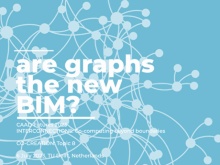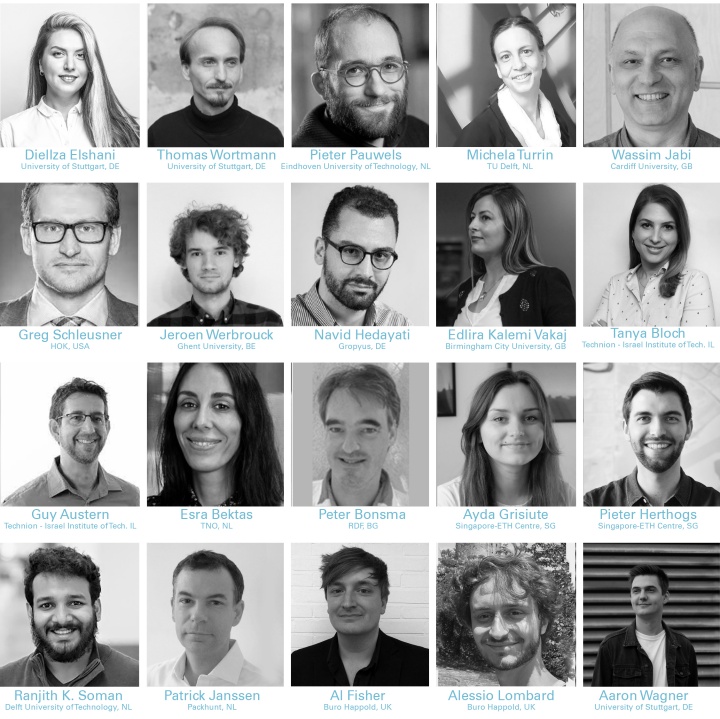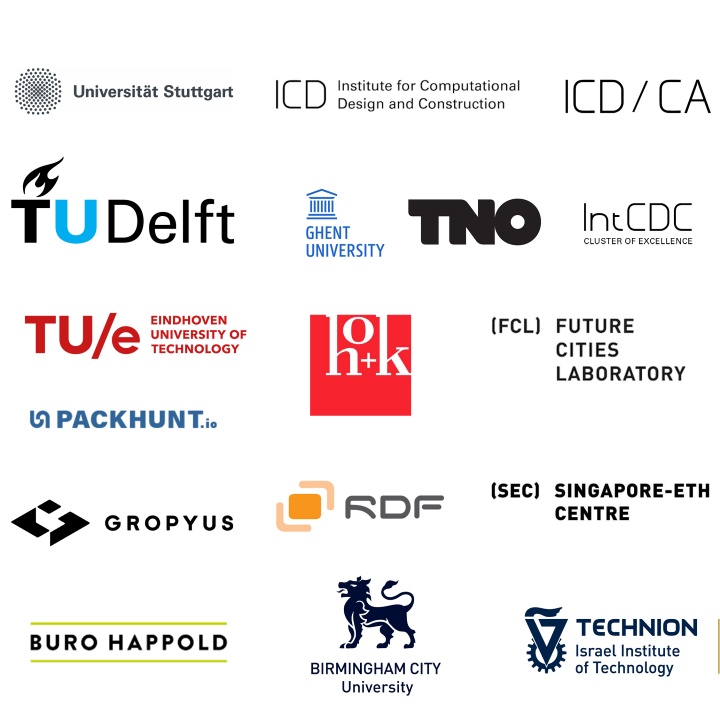INTERCONNECTIONS: Co-Computing beyond boundaries
Co-Creation Event
Introduction
The way knowledge is represented influences how the design is explored and analyzed. Current object-oriented data models are rich in terms of semantics and geometric information; however, they do not prioritize the relationships between data or the validation and reasoning of data. In this co-creation session, we, as a group of researchers and experts from academia and industry, elaborated on graph data models as an extension to current object-oriented building information models. We investigated several topics, including data modelling strategies, data interoperability issues, co-design with graphs, evaluation of graph data models for the AEC industry, data federation, etc. Furthermore, we discussed how complex queries on graphs can help recognize violated design constraints from the early design stages. The structure of our event consisted of three online sessions, followed by a co-creation day on site during the CAAD futures conference, where we discussed all the topics of the three sessions in a hybrid format, and interacted with more conference participants who shared their insights on the topic. Moreover, during this live event, we also co-created a knowledge graph of all participants.
Content of the sessions:
In Session 1, the focus was on using graphs for building co-design with The Buildings and Habitats object Model (BHoM), federated data storage, topological approaches for BIM data, end-to-end value chain integration, and leveraging Linked Data to enhance competitiveness in the construction industry. Session 2 delved into design transfer assembly, employing graph-based methods for processing BIM data, using Linked Data-based to codify and transfer tacit construction project knowledge, graph-based portfolio-level public asset management and streamline synthesis actions in urban planning, including querying planning regulation and simulating its impact. Session 3 introduced graph applications in Natural Language Processing (NLP) for extracting rules from regulatory documents and aligning them with predefined ontologies. It proposed material passports for BIM elements as part of traceable geographically distributed graphs. Finally, applications of graph neural networks (GNNs) for unstructured geometric data in BIM were discussed. The fourth and final session was an on-site event with a substantial turnout, featuring twelve presentations, in-depth discussions, and collaborative knowledge graph creation involving both in-person and remote participants. These sessions highlighted varying degrees of support for different applications, which we summarize in the following arguments.
Arguments:
Graphs offer a flexible and scalable data model that effectively represents complex topological (Aish et al., 2018) relations and dependencies within the building industry. Additionally, leveraging graph-based approaches in the building industry promotes improved data interoperability, automation of expensive processes (Janssen, 2023), efficient design coordination (Elshani, Wortmann, et al., 2022), supports business operations (Gropyus, n.d.), cross-domain integration (Schleusner 2023), and early detection of design constraint violations, leading to more efficient and sustainable construction projects. Reasoning over graph can be used to support and trace processes through the entire lifecycle of a construction project and across different domains, like early stage co-design (Elshani, Wortmann, et al., 2022), urban planning (Grisiute, et al., 2023) or resource management (Bektas, 2023).
Counter arguments. Despite supporting evidence for a widespread shift in AEC to graph-based approaches, concerns have arisen. Critics in the building industry worry about the challenges of selecting appropriate graph representations for tasks like geometric data modelling. Various graph representations exist, including undirected and directed graphs, directed edge-labelled graphs (knowledge graphs), property graphs, hypergraphs, and heterogeneous graphs, each with unique characteristics and suitability for different scenarios (Hogan et al., 2021, Donkers et al., 2020). This underscores the complexity of choosing the right graph data model for each specific AEC problem and a need for domain professionals to build related knowledge capacity. At the urban planning scale, establishing general knowledge semantics for urban planning is a slower process compared to traditional domain knowledge representation. The AEC domain's diverse experts with their own practices make achieving alignment and semantic consistency a challenge. Furthermore, widespread adoption of ontologies requires striking a balance in urban data representation that is both machine-readable and comprehensible to domain professionals (Grisiute, et al., 2023).
Vision:
The "Are graphs the new BIM?" co-creation team aimed to foster the use of graphs for knowledge representation in the building industry, enhancing data modelling, management, and decision-making. While the discussed projects showcased compelling applications of knowledge graphs in the AEC domain, several future directions were envisioned. First, further focusing on scalability, interoperability, secure and efficient data sharing (Gropyus, n.d., Werbrouck et al., 2021). Second, bringing new possibilities for innovative and context-aware urban design solutions by bridging the gap between deep generative models and graph theory (Lin et al., 2023). Third, continue exploring advanced reasoning techniques and standardised ontologies to build a broader application spectrum within the construction and planning projects, such as extensive policy change assessments (Vakaj et al., 2023, Grisiute et al. 2023).
Co-Creation team members:
This co-creation event was initiated by RA, PhD. Cand. Diellza Elshani and Tenure-Track Professor Dr. Thomas Wortmann from the chair for Computing in Architecture at the Institute for Computational Design and Construction (ICD/CA) at the University of Stuttgart.
All working members: Diellza Elshani, University of Stuttgart, DE | Knowledge Graphs || Thomas Wortmann, University of Stuttgart, DE | Computational Design || Pieter Pauwels, Eindhoven University of Technology, NL | Linked Building Data || Michela Turrin, TU Delft, NL | Computational Design || Wassim Jabi, Cardiff University, GB | BIM || Ayda Grisiute, Singapore-ETH Centre, SG | Trans-disciplinary urban research || Pieter Herthogs, Singapore-ETH Centre, SG | Trans-disciplinary urban research || Greg Schleusner, Director of Design Technology HOK | Computational Design || Jeroen Werbrouck, Ghent University, BE | Federated data storage || Navid Hedayati, Gropyus, DE | BIM || Edlira Kalemi Vakaj, Birmingham City University, GB | Semantic Web Technologies || Tanya Bloch, Technion - Israel Institute of Technology, IL | BIM || Guy Austern, Technion - Israel Institute of Technology, IL | Machine Learning || Esra Bektas, TNO, NL | Knowledge Modelling || Peter Bonsma, Technical Director at RDF, BG | Mathematical algorithms || Ranjith K. Soman, Delft University of Technology, NL | Construction Informatics || Patrick Janssen, Head of Research at Packhunt, NL | Computational Design || Al Fisher, Buro Happold, UK | Computational Design || Alessio Lombardi, Buro Happold, UK | Interoperability, Machine Learning || Aaron Wagner, University of Stuttgart, DE | Computational Design ||
References:
Aish, Robert & Jabi, Wassim & Lannon, Simon & Wardhana, Nicholas & Chatzivasileiadi, Aikaterini. (2018). Topologic: tools to explore architectural topology.
Donkers, A., Yang, D., & Baken, N. (2020). Linked Data for Smart Homes: Comparing RDF and Labeled Property Graphs.
Elshani, D., Lombardi, A., Fisher, A., Hernandez, D., Staab, S., & Wortmann, T. (2022). Inferential Reasoning in Co-Design Using Semantic Web Standards Alongside BHoM. 33. Forum Bauinformatik 2022, Munich.
Elshani, D., Wortmann, T., & Staab, S. (2022). Towards Better Co-Design with Disciplinary Ontologies: Review and Evaluation of Data Interoperability in the AEC Industry. CEUR-WS Proceedings. Linked Data in Architecture and Construction 2022.
Gropyus. (n.d.). https://www.gropyus.com/
Hogan, A., Blomqvist, E., Cochez, M., d’Amato, C., de Melo, G., Gutierrez, C., Kirrane, S., Labra Gayo, J. E., Navigli, R., & Neumaier, S. (2021). Knowledge Graphs. Morgan & Claypool Publishers. https://doi.org/10.2200/S01125ED1V01Y202109DSK022
Knublauch, H. (2017). Shapes Constraint Language (SHACL). https://www.w3.org/TR/shacl/
Lin, B., Jabi, W., Corcoran, P., & Lannon, S. (2023). The application of deep generative models in urban form generation based on topology: A review. Architectural Science Review, 1–16. https://doi.org/10.1080/00038628.2023.2209550
Mirarchi, C., Simeone, D., Sivieri, L., & Pavan, A. (2023). Knowledge Discovery Framework for Decision Support Systems in Tendering, Cost Analysis and Construction Phases. In E. Favari & F. Cantoni (Eds.), Complexity and Sustainability in Megaprojects (Vol. 342, pp. 123–134). Springer Nature Switzerland. https://doi.org/10.1007/978-3-031-30879-6_10
Werbrouck, J., Pauwels, P., Beetz, J., & Mannens, E. (2021). Data Patterns for the Organisation of Federated Linked Building Data.
Grisiute, A., Silvennoinen, H., Li, S., Chadzynski, A., Raubal, M., Kraft, M., Von Richthofen, A., & Herthogs, P. (2023). A Semantic Spatial Policy Model to Automatically Calculate Allowable Gross Floor Areas in Singapore. In M. Turrin, C. Andriotis, & A. Rafiee (Eds.), Computer-Aided Architectural Design. INTERCONNECTIONS: Co-computing Beyond Boundaries (Vol. 1819, pp. 455–469). Springer Nature Switzerland. https://doi.org/10.1007/978-3-031-37189-9_30
Bektas, E., Oord, E., Kohler, J. and Sánchez-Rodríguez, A. (2023), Semantic knowledge models for decision making in asset management: IM-SAFE Knowledge Base. ce/papers, 6: 619-626. https://doi.org/10.1002/cepa.2212
Edlira Vakaj, Maxime Lefrançois, Amna Dridi, Thomas Beach, Mohamed Gaber, et al.. Semantisation of Rules for Automated Compliance Checking. LDAC2023 - Linked Data in Architecture and Construction Week, Jun 2023, Matera, Italy. ⟨emse-04079411⟩
Co-Creation Event
Introduction
The way knowledge is represented influences how the design is explored and analyzed. Current object-oriented data models are rich in terms of semantics and geometric information; however, they do not prioritize the relationships between data or the validation and reasoning of data. In this co-creation session, we, as a group of researchers and experts from academia and industry, elaborated on graph data models as an extension to current object-oriented building information models. We investigated several topics, including data modelling strategies, data interoperability issues, co-design with graphs, evaluation of graph data models for the AEC industry, data federation, etc. Furthermore, we discussed how complex queries on graphs can help recognize violated design constraints from the early design stages. The structure of our event consisted of three online sessions, followed by a co-creation day on site during the CAAD futures conference, where we discussed all the topics of the three sessions in a hybrid format, and interacted with more conference participants who shared their insights on the topic. Moreover, during this live event, we also co-created a knowledge graph of all participants.
Content of the sessions:
In Session 1, the focus was on using graphs for building co-design with The Buildings and Habitats object Model (BHoM), federated data storage, topological approaches for BIM data, end-to-end value chain integration, and leveraging Linked Data to enhance competitiveness in the construction industry. Session 2 delved into design transfer assembly, employing graph-based methods for processing BIM data, using Linked Data-based to codify and transfer tacit construction project knowledge, graph-based portfolio-level public asset management and streamline synthesis actions in urban planning, including querying planning regulation and simulating its impact. Session 3 introduced graph applications in Natural Language Processing (NLP) for extracting rules from regulatory documents and aligning them with predefined ontologies. It proposed material passports for BIM elements as part of traceable geographically distributed graphs. Finally, applications of graph neural networks (GNNs) for unstructured geometric data in BIM were discussed. The fourth and final session was an on-site event with a substantial turnout, featuring twelve presentations, in-depth discussions, and collaborative knowledge graph creation involving both in-person and remote participants. These sessions highlighted varying degrees of support for different applications, which we summarize in the following arguments.
Arguments:
Graphs offer a flexible and scalable data model that effectively represents complex topological (Aish et al., 2018) relations and dependencies within the building industry. Additionally, leveraging graph-based approaches in the building industry promotes improved data interoperability, automation of expensive processes (Janssen, 2023), efficient design coordination (Elshani, Wortmann, et al., 2022), supports business operations (Gropyus, n.d.), cross-domain integration (Schleusner 2023), and early detection of design constraint violations, leading to more efficient and sustainable construction projects. Reasoning over graph can be used to support and trace processes through the entire lifecycle of a construction project and across different domains, like early stage co-design (Elshani, Wortmann, et al., 2022), urban planning (Grisiute, et al., 2023) or resource management (Bektas, 2023).
Counter arguments. Despite supporting evidence for a widespread shift in AEC to graph-based approaches, concerns have arisen. Critics in the building industry worry about the challenges of selecting appropriate graph representations for tasks like geometric data modelling. Various graph representations exist, including undirected and directed graphs, directed edge-labelled graphs (knowledge graphs), property graphs, hypergraphs, and heterogeneous graphs, each with unique characteristics and suitability for different scenarios (Hogan et al., 2021, Donkers et al., 2020). This underscores the complexity of choosing the right graph data model for each specific AEC problem and a need for domain professionals to build related knowledge capacity. At the urban planning scale, establishing general knowledge semantics for urban planning is a slower process compared to traditional domain knowledge representation. The AEC domain's diverse experts with their own practices make achieving alignment and semantic consistency a challenge. Furthermore, widespread adoption of ontologies requires striking a balance in urban data representation that is both machine-readable and comprehensible to domain professionals (Grisiute, et al., 2023).
Vision:
The "Are graphs the new BIM?" co-creation team aimed to foster the use of graphs for knowledge representation in the building industry, enhancing data modelling, management, and decision-making. While the discussed projects showcased compelling applications of knowledge graphs in the AEC domain, several future directions were envisioned. First, further focusing on scalability, interoperability, secure and efficient data sharing (Gropyus, n.d., Werbrouck et al., 2021). Second, bringing new possibilities for innovative and context-aware urban design solutions by bridging the gap between deep generative models and graph theory (Lin et al., 2023). Third, continue exploring advanced reasoning techniques and standardised ontologies to build a broader application spectrum within the construction and planning projects, such as extensive policy change assessments (Vakaj et al., 2023, Grisiute et al. 2023).
Co-Creation team members:
This co-creation event was initiated by RA, PhD. Cand. Diellza Elshani and Tenure-Track Professor Dr. Thomas Wortmann from the chair for Computing in Architecture at the Institute for Computational Design and Construction (ICD/CA) at the University of Stuttgart.
All working members: Diellza Elshani, University of Stuttgart, DE | Knowledge Graphs || Thomas Wortmann, University of Stuttgart, DE | Computational Design || Pieter Pauwels, Eindhoven University of Technology, NL | Linked Building Data || Michela Turrin, TU Delft, NL | Computational Design || Wassim Jabi, Cardiff University, GB | BIM || Ayda Grisiute, Singapore-ETH Centre, SG | Trans-disciplinary urban research || Pieter Herthogs, Singapore-ETH Centre, SG | Trans-disciplinary urban research || Greg Schleusner, Director of Design Technology HOK | Computational Design || Jeroen Werbrouck, Ghent University, BE | Federated data storage || Navid Hedayati, Gropyus, DE | BIM || Edlira Kalemi Vakaj, Birmingham City University, GB | Semantic Web Technologies || Tanya Bloch, Technion - Israel Institute of Technology, IL | BIM || Guy Austern, Technion - Israel Institute of Technology, IL | Machine Learning || Esra Bektas, TNO, NL | Knowledge Modelling || Peter Bonsma, Technical Director at RDF, BG | Mathematical algorithms || Ranjith K. Soman, Delft University of Technology, NL | Construction Informatics || Patrick Janssen, Head of Research at Packhunt, NL | Computational Design || Al Fisher, Buro Happold, UK | Computational Design || Alessio Lombardi, Buro Happold, UK | Interoperability, Machine Learning || Aaron Wagner, University of Stuttgart, DE | Computational Design ||
References:
Aish, Robert & Jabi, Wassim & Lannon, Simon & Wardhana, Nicholas & Chatzivasileiadi, Aikaterini. (2018). Topologic: tools to explore architectural topology.
Donkers, A., Yang, D., & Baken, N. (2020). Linked Data for Smart Homes: Comparing RDF and Labeled Property Graphs.
Elshani, D., Lombardi, A., Fisher, A., Hernandez, D., Staab, S., & Wortmann, T. (2022). Inferential Reasoning in Co-Design Using Semantic Web Standards Alongside BHoM. 33. Forum Bauinformatik 2022, Munich.
Elshani, D., Wortmann, T., & Staab, S. (2022). Towards Better Co-Design with Disciplinary Ontologies: Review and Evaluation of Data Interoperability in the AEC Industry. CEUR-WS Proceedings. Linked Data in Architecture and Construction 2022.
Gropyus. (n.d.). https://www.gropyus.com/
Hogan, A., Blomqvist, E., Cochez, M., d’Amato, C., de Melo, G., Gutierrez, C., Kirrane, S., Labra Gayo, J. E., Navigli, R., & Neumaier, S. (2021). Knowledge Graphs. Morgan & Claypool Publishers. https://doi.org/10.2200/S01125ED1V01Y202109DSK022
Knublauch, H. (2017). Shapes Constraint Language (SHACL). https://www.w3.org/TR/shacl/
Lin, B., Jabi, W., Corcoran, P., & Lannon, S. (2023). The application of deep generative models in urban form generation based on topology: A review. Architectural Science Review, 1–16. https://doi.org/10.1080/00038628.2023.2209550
Mirarchi, C., Simeone, D., Sivieri, L., & Pavan, A. (2023). Knowledge Discovery Framework for Decision Support Systems in Tendering, Cost Analysis and Construction Phases. In E. Favari & F. Cantoni (Eds.), Complexity and Sustainability in Megaprojects (Vol. 342, pp. 123–134). Springer Nature Switzerland. https://doi.org/10.1007/978-3-031-30879-6_10
Werbrouck, J., Pauwels, P., Beetz, J., & Mannens, E. (2021). Data Patterns for the Organisation of Federated Linked Building Data.
Grisiute, A., Silvennoinen, H., Li, S., Chadzynski, A., Raubal, M., Kraft, M., Von Richthofen, A., & Herthogs, P. (2023). A Semantic Spatial Policy Model to Automatically Calculate Allowable Gross Floor Areas in Singapore. In M. Turrin, C. Andriotis, & A. Rafiee (Eds.), Computer-Aided Architectural Design. INTERCONNECTIONS: Co-computing Beyond Boundaries (Vol. 1819, pp. 455–469). Springer Nature Switzerland. https://doi.org/10.1007/978-3-031-37189-9_30
Bektas, E., Oord, E., Kohler, J. and Sánchez-Rodríguez, A. (2023), Semantic knowledge models for decision making in asset management: IM-SAFE Knowledge Base. ce/papers, 6: 619-626. https://doi.org/10.1002/cepa.2212
Edlira Vakaj, Maxime Lefrançois, Amna Dridi, Thomas Beach, Mohamed Gaber, et al.. Semantisation of Rules for Automated Compliance Checking. LDAC2023 - Linked Data in Architecture and Construction Week, Jun 2023, Matera, Italy. ⟨emse-04079411⟩




